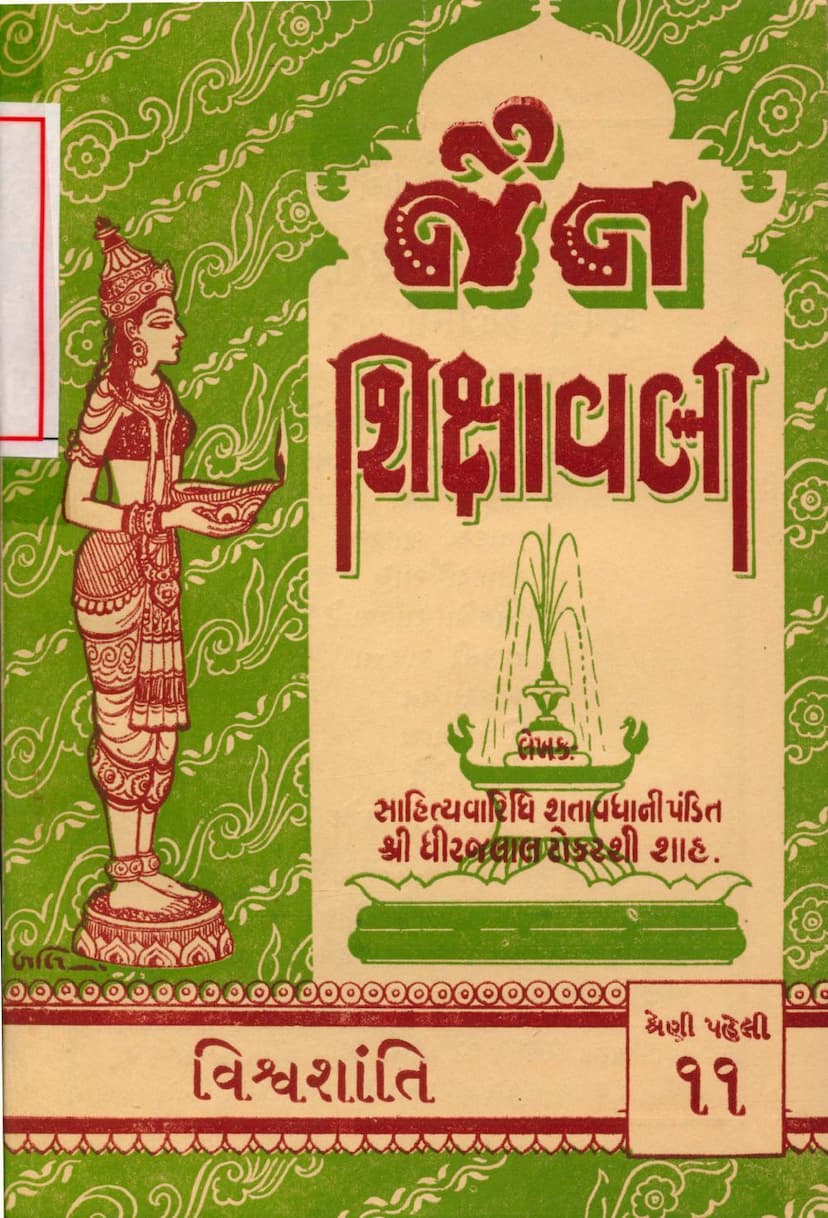Jain Shikshavali Vishvashanti
Added to library: September 2, 2025

Summary
This Jain text, titled "Jain Shikshavali Vishvashanti" (Jain Educational Series: World Peace), authored by Dhirajlal Tokarshi Shah and published by Jain Sahitya Prakashan Mandir, is the eleventh book in the first series of Jain educational texts.
The book is dedicated to the subject of World Peace and aims to present Jain philosophy and conduct in a simple and elegant style.
The table of contents reveals a comprehensive exploration of the theme:
- Purpose of the Essay: Explains that world peace is not merely a political issue but a fundamental question of humanity and an integral part of religion.
- Meaning of World Peace: Defines "world" (Vishva) as all existent things, the universe, and its vastness as understood in Jain cosmology, contrasting it with modern scientific concepts of the universe. It also defines "peace" (Shanti) from various perspectives such as the cessation of desires, mental tranquility, removal of obstacles, absence of war, and the Jain concept of the calming of passions or avoidance of sin.
- The Increasingly Terrifying Nature of War: Traces the historical evolution of warfare, starting from early human societies and progressing through the era of kings like Shri Rishabhdev, the development of human civilization, the epic Mahabharata, and the devastating World Wars of the 20th century. It highlights the escalating destructive power of weapons and the immense loss of life and societal damage caused by wars.
- Opinions of Great Minds on Atomic Weapons: Presents the views of prominent figures like Albert Einstein, Nobel laureates, and Indian leaders such as C. Rajagopalachari, President Dr. Rajendra Prasad, and Prime Minister Jawaharlal Nehru, all of whom expressed grave concerns about the destructive potential of nuclear weapons and the existential threat they pose to humanity. It also quotes Sant Vinoba Bhave on the catastrophic outcome of combining science with violence.
- Efforts for World Peace and Our Duty: Discusses the establishment of the League of Nations and the United Nations as attempts to achieve world peace. However, it critically examines their effectiveness, pointing out the failure to resolve major issues and the paradox of nations pursuing peace while simultaneously investing heavily in arms and nuclear weapons. The text emphasizes that true peace requires mutual understanding, empathy, and a willingness to compromise, rather than solely focusing on self-interest.
- The "What About Us?" Attitude is Not Beneficial: Argues against indifference towards global conflicts, using an allegorical story of monkeys in a royal palace to illustrate how a seemingly detached attitude can lead to unforeseen and devastating consequences. It highlights the interconnectedness of the world and how events in one part can affect others.
- Appropriate Reflection Can Bring Wonderful Change: Emphasizes the power of thought and public opinion in shaping world events, particularly in democratic societies. It argues that wars are born from negative thoughts and desires (like ambition, greed, and hatred), and conversely, peace can be cultivated through positive thoughts and a change in mindset.
- The Example of a Millionaire Seth: Recounts a story about a wealthy merchant obsessed with accumulating a specific fortune, leading to immense stress, ill health, and a loss of spiritual well-being. Through the intervention of a wise ascetic, the merchant realizes the futility of excessive attachment to wealth and the impossibility of taking material possessions with him after death, leading to a change of heart and a focus on spiritual pursuits. This story serves as a cautionary tale against greed and underscores the importance of contentment.
- The Other Side of Scientific Tools: Critically examines the impact of modern scientific advancements. While acknowledging the conveniences, it highlights the negative consequences such as the erosion of natural physical abilities (walking, eyesight, resilience to weather), increased reliance on technology, rising cost of living, and the creation of social classes leading to conflict. It suggests that true happiness and peace lie in simple living and contentment, rather than endless pursuit of material comforts.
- The Teachings of the Rishis for World Peace: Cites Jain scriptures and the teachings of Jain sages, emphasizing the importance of self-control, inner spiritual battle against vices (anger, pride, deceit, greed), and the virtues of forgiveness, humility, honesty, and contentment. It highlights the Jain principle of Ahimsa (non-violence) and Abhay (fearlessness) as foundational to achieving world peace. The text draws parallels with Buddhist principles but asserts the superiority of Jain ethical codes, particularly the emphasis on controlling possessions (parigraha) as a means to prevent economic inequality and greed, which are seen as root causes of conflict.
In essence, "Jain Shikshavali Vishvashanti" advocates for a profound internal transformation, urging individuals to cultivate peace within themselves by overcoming negative impulses and embracing virtues like forgiveness, contentment, and compassion. It posits that true world peace begins with individual peace and that the teachings of Jainism offer a robust framework for achieving this, both on a personal and global level. The book challenges modern societal values driven by materialism and scientific prowess alone, calling for a return to spiritual and ethical principles as the path to genuine and lasting world peace.